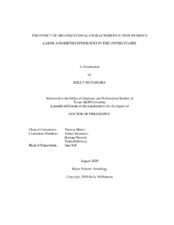| dc.description.abstract | In recent years, women’s reproductive healthcare has gained much attention. This is in part due to the work of the reproductive justice movement, which has exposed the ways in which reproductive health is stratified by race and socioeconomic status in the United States and how this stratification is upheld by public policies and social institutions (Ross & Solinger 2017). One factor that affects women’s labor and birth experiences that is often overlooked, is organizational characteristics. To better understand women’s labor experiences and outcomes and how it can be stratified by race and class, this research combines the reproductive justice framework with an organizational hospital-based analysis of labor and birth experiences and outcomes. The dissertation utilizes a mixed-methods approach to analyze how organizational characteristics (i.e. ownership status, size, and financial measures) at a meso level affect patient experiences at the micro level (mode of delivery, patient care, etc.). The data comes from Childbirth Connection’s Listening to Mothers III survey, a nationally representative online survey that sampled 2,400 women aged 18-45, and asked women about their birth experiences. This research examines the intersection between organizational and reproduction studies by illuminating how organizational behavior, driven by concerns for efficiency and liability, affects patient experiences. In addition, I aim to examine if organizational characteristics also influence how women of color and lower SES experience labor and birth. Ultimately, I situate this reproductive justice topic within an organizational theory context, and utilize organizational theory to examine how organizational characteristics and behavior affect patient experiences and procedures from an intersectional perspective by examining if and how women’s labor and birth experiences vary according to race and socioeconomic status. This research explains 1) how organizational characteristics affect the likelihood of a respondent having a cesarean delivery, 2) how procedures such as labor induction and EFM happen frequently and are affected by individual characteristics, and 3) how women of color and low SES are more likely to report experiencing discrimination during labor and birth. | en |


